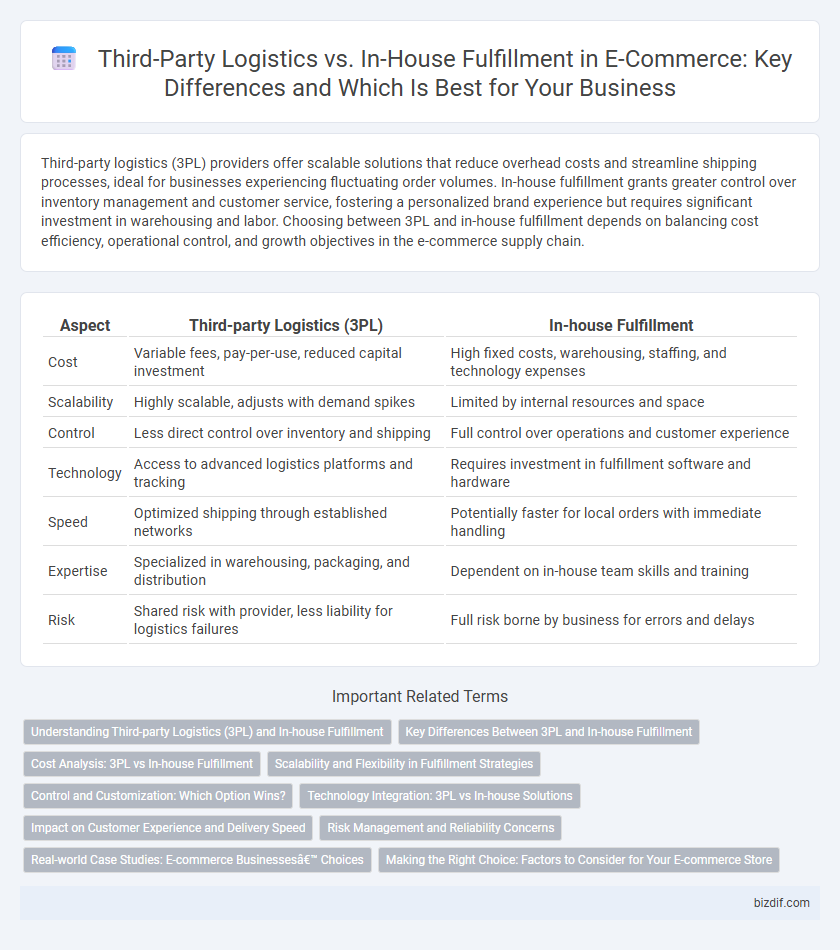Third-party logistics (3PL) providers offer scalable solutions that reduce overhead costs and streamline shipping processes, ideal for businesses experiencing fluctuating order volumes. In-house fulfillment grants greater control over inventory management and customer service, fostering a personalized brand experience but requires significant investment in warehousing and labor. Choosing between 3PL and in-house fulfillment depends on balancing cost efficiency, operational control, and growth objectives in the e-commerce supply chain.
Table of Comparison
| Aspect | Third-party Logistics (3PL) | In-house Fulfillment |
|---|---|---|
| Cost | Variable fees, pay-per-use, reduced capital investment | High fixed costs, warehousing, staffing, and technology expenses |
| Scalability | Highly scalable, adjusts with demand spikes | Limited by internal resources and space |
| Control | Less direct control over inventory and shipping | Full control over operations and customer experience |
| Technology | Access to advanced logistics platforms and tracking | Requires investment in fulfillment software and hardware |
| Speed | Optimized shipping through established networks | Potentially faster for local orders with immediate handling |
| Expertise | Specialized in warehousing, packaging, and distribution | Dependent on in-house team skills and training |
| Risk | Shared risk with provider, less liability for logistics failures | Full risk borne by business for errors and delays |
Understanding Third-party Logistics (3PL) and In-house Fulfillment
Third-party logistics (3PL) involves outsourcing order fulfillment, warehousing, and shipping to specialized providers, allowing e-commerce businesses to scale quickly and reduce operational complexities. In-house fulfillment requires managing storage, packing, and shipping internally, offering greater control but demanding more resources and infrastructure. Choosing between 3PL and in-house fulfillment depends on factors like order volume, budget, and desired flexibility in the supply chain.
Key Differences Between 3PL and In-house Fulfillment
Third-party logistics (3PL) providers offer scalable warehousing, shipping, and inventory management services that reduce operational complexity for e-commerce businesses, while in-house fulfillment requires direct control over storage, labor, and distribution costs. 3PL solutions typically leverage advanced technology platforms and global carrier networks to optimize delivery speed and reduce shipping expenses, whereas in-house fulfillment allows for personalized packaging and tighter quality control. Choosing between 3PL and in-house fulfillment hinges on factors like order volume, desired customer experience, and capital investment capacity.
Cost Analysis: 3PL vs In-house Fulfillment
Third-party logistics (3PL) often reduces upfront investment by outsourcing warehousing, labor, and shipping costs, allowing businesses to convert fixed expenses into variable costs. In-house fulfillment requires significant capital expenditures on warehouse space, technology, and staffing, leading to higher fixed costs but greater control over operations. Cost efficiency depends on order volume, with 3PLs favoring scalability for small to mid-sized businesses while in-house fulfillment can be cost-effective for large-scale, predictable demand.
Scalability and Flexibility in Fulfillment Strategies
Third-party logistics (3PL) providers offer scalable solutions that easily adjust to fluctuating order volumes, reducing the need for costly infrastructure investments during peak seasons. In-house fulfillment grants greater control and customization but often struggles with rapid scaling due to fixed warehouse space and labor constraints. Balancing scalability and flexibility in fulfillment strategies is crucial for e-commerce businesses aiming to optimize costs and respond swiftly to market demands.
Control and Customization: Which Option Wins?
In e-commerce, in-house fulfillment offers greater control over inventory management, packaging, and delivery schedules, allowing businesses to tailor the customer experience precisely. Third-party logistics (3PL) providers offer limited customization but provide scalability and access to advanced technology without the need for substantial upfront investment. Businesses prioritizing brand consistency and unique customer service often prefer in-house fulfillment, while those focused on efficiency and cost savings lean towards 3PL solutions.
Technology Integration: 3PL vs In-house Solutions
Third-party logistics providers offer advanced technology integration with real-time inventory tracking, automated order processing, and seamless API connections to e-commerce platforms, enhancing operational efficiency. In-house fulfillment requires significant investment in proprietary software development and ongoing maintenance to achieve comparable technology capabilities, which can limit scalability. Businesses must evaluate the tech infrastructure flexibility and data synchronization needs to decide between 3PL and in-house solutions.
Impact on Customer Experience and Delivery Speed
Third-party logistics (3PL) providers enhance customer experience by offering faster and more reliable delivery through established networks and advanced tracking technologies. In-house fulfillment enables greater control over packaging and customization, which can improve brand consistency but may limit scalability and speed during peak demand. Balancing 3PL efficiency with in-house personalization is crucial for optimizing delivery speed and maintaining high customer satisfaction in e-commerce.
Risk Management and Reliability Concerns
Third-party logistics (3PL) providers offer enhanced risk management by leveraging specialized expertise, advanced technology, and diversified networks to mitigate supply chain disruptions and reduce fulfillment errors. In-house fulfillment demands substantial investment in infrastructure and staffing, increasing vulnerability to operational risks such as inventory mismanagement and delayed shipments. Reliability concerns favor 3PLs due to their scalable resources, real-time tracking capabilities, and established contingency plans that ensure consistent order accuracy and timely delivery.
Real-world Case Studies: E-commerce Businesses’ Choices
E-commerce businesses often face the choice between third-party logistics (3PL) and in-house fulfillment, with case studies revealing varied preferences based on scale and complexity. Companies like Zappos leverage 3PL for expansive geographic reach and cost efficiency, while Amazon initially relied on in-house fulfillment to maintain control but gradually expanded 3PL partnerships for flexibility. Real-world examples demonstrate that small to mid-sized e-commerce brands often prefer 3PL for scalability, whereas large enterprises balance both methods to optimize delivery speed and customer service.
Making the Right Choice: Factors to Consider for Your E-commerce Store
Choosing between third-party logistics (3PL) and in-house fulfillment depends on factors such as order volume, budget flexibility, and control over the supply chain. E-commerce businesses with fluctuating demand often benefit from 3PL providers due to scalability and reduced overhead costs, while in-house fulfillment offers greater customization and direct quality control. Assessing delivery speed requirements, storage capabilities, and technology integration are critical for optimizing customer satisfaction and operational efficiency.
Third-party Logistics vs In-house Fulfillment Infographic

 bizdif.com
bizdif.com